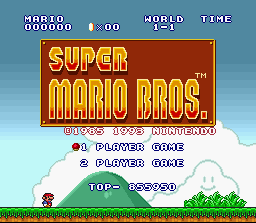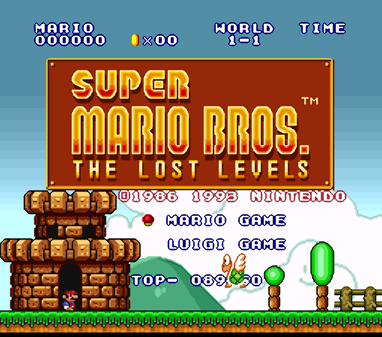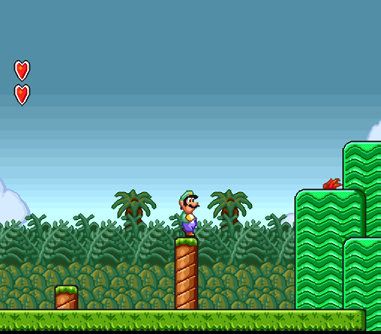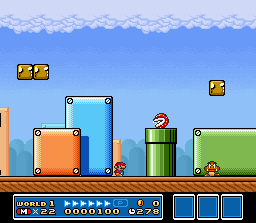Super Mario All Stars
Released: 1993
Super Mario Bros. and Super Mario Bros.: The Lost Levels
Several changes were made to Super Mario Bros. for this enhanced remake. The player now gains 50 points for every second left on the timer after the last level of each world. Players no longer need to hold A while pressing Start to continue, because they can now continue from a saved game. Bowser , Princess Peach , and the mushroom retainers have been given new animations, and new background music plays during encounters with Bowser. Maze levels such as World 4-4 and 7-4 in Super Mario Bros. , now have sound effects that indicate the correct path for Mario or Luigi to take, a trait which was carried over to Super Mario Bros. Deluxe and New Super Mario Bros. Collisions with the pipe-plants include the top eight pixels. Essentially, if Mario or Luigi jumps and lands directly on the top of a Piranha Plant, he will be unharmed and fall through (in the original, all enemies except Bowser collided as 16x16, even if they looked larger). The Minus world glitch for Super Mario Bros. was removed from the game when it made its transition to All-Stars , as was the small Fire Mario glitch. However a similar glitch reappeared in the Japanese version of Super Mario Bros. Deluxe.

Worlds A through D in Super Mario Bros.: The Lost Levels are not hidden in the Super Mario All-Stars version. In the original version, the player has to complete the game eight times, and must hold A and press Start to access Worlds A through D. In the Super Mario All-Stars version, he or she can access them on the fly, either from World 8-4 if warp zones were used, or World 9-4 otherwise.
World 9 was a hidden world that could only be reached if players played through the game to Bowser without using any warp pipes. If players did use any warps, whether forward or backward, they would skip World 9 to world A. World 9 is a strange world in that Bowser is not fought in his castle, nor the final level: Bowser is fought in World 9-3.
In the original version of Super Mario Bros.: The Lost Levels , when a player loses all of his or her lives, he or she has to restart from the beginning of the world, as the player would in Super Mario Bros. In the Super Mario All-Stars version, he or she can restart in the level he or she lost on. The same goes for saving the game. The player still has to restart from the beginning of the world in the Super Mario All-Stars version of Super Mario Bros.
The Super Mario All-Stars + Super Mario World version of the Super Mario Bros.: The Lost Levels has a very minor difference. In the game select screen, the boxart for the game says "unreleased in Europe/the USA".

In the Japanese version, the title screen shows "Super Mario Bros. 2 for Super Players", which is named after the medal on the original version's box that said "for Super Players".
Super Mario Bros. 2/Super Mario USA
Super Mario Bros. 2 , or Super Mario USA (as it is known in Japan ), was given the most enhancement. Level introductions now feature a colorized and animated level representation. The slot machine bonus game has been enhanced, including enlarged slots and icons, and a new "7" icon. In the Famicom/NES version, the player can only get up to five extra lives; however, in the Super Famicom/SNES version, with the addition of the "7" icon, the player can now get up to ten extra lives. As for continuing after losing the last life, on the Famicom/NES version, the player can only continue twice per game. However, on the Super Famicom/SNES version, the player can continue the game any number of times, because he or she can continue from a saved game. In the Famicom/NES version, the player can select a character at the beginning of each level, but must play as the character for the length of the level. In the Super Famicom/SNES version, the player can select a character at the beginning of each level and may change the character upon losing a life. Super Mario Advance is based on the All-Stars version of Super Mario Bros. 2 . Also note that the US version of Super Mario Brothers 2 was originally Doki Doki Panic , but Nintendo changed the characters. This is why the gameplay and enemies are so different.

While Super Mario Bros. 3 had significant graphical enhancements, the game wasn't given upgrades to the extent that Super Mario Bros. 2 was. The action scenes, spade panels, and other world map elements have been animated. The kings' original animal forms were replaced with monsters from other various Mario games such as Donkey Kong , Super Mario Bros. 2 , and Super Mario World ; for instance, the king in World 7 is now transformed into a Yoshi instead of a Piranha Plant, as he was in the Famicom/NES version, which pre-dates the time Shigefumi Hino created Yoshi. The Super Famicom/SNES version is closer to the Japanese Famicom version than to the American NES version, but is still a combination of the two. The "suit flying off" animation that was on the Japanese Famicom version was dummied out of the American NES version, but it was put back in on the Super Famicom/SNES version. Super Mario Advance 4: Super Mario Bros. 3 is based on the Super Famicom/SNES version of Super Mario Bros. 3 . Parallax scrolling in the backgrounds, a graphical capability that was used this version, was taken out of most levels the GBA version, making the game look slightly worse in terms of depth. The parallax scrolling is comparable to Super Mario World which only had 2 layers throughout each level. However, some players may notice that clouds in the background "overlap" the mountains when they fly up. In some All-Star games the select button causes Mario to transform.


